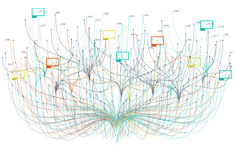In today’s article, let’s delve further into computer vision, where instance and semantic segmentation are pivotal techniques, uniquely transforming our visual data interpretation approach. With its precision in delineating every object, instance segmentation shines in applications demanding meticulous boundary definition, such as autonomous driving and medical imaging. Conversely, semantic segmentation paints each pixel purposefully, categorizing entire scenes into meaningful regions, which is ideal for comprehensive scene understanding.
For those interested in computer vision’s potential, semantic segmentation offers a canvas on which the future of technology can be vividly imagined and creatively explored, promising discovery and innovation.
Understanding Instance Segmentation
Instance segmentation is a powerful technique for identifying and separating individual objects within an image. It goes beyond simple object classification by providing a pixel-level understanding of the scene. Each object is labelled and precisely delineated, allowing for a detailed representation of the objects’ boundaries.
One of the main advantages of instance segmentation is its ability to handle complex scenes with overlapping objects. By accurately separating each instance, it enables more accurate analysis and recognition of objects. This makes it particularly valuable in applications such as autonomous driving, where the precise detection and tracking of vehicles, pedestrians, and other objects are essential.
Additionally, instance segmentation is extensively used in medical imaging. It allows for precisely delineating tumours, organs, or other anatomical structures, enabling better diagnosis and treatment planning. By providing a detailed understanding of the spatial relationships between objects, instance segmentation aids in identifying abnormalities and guiding medical interventions.
Despite its advantages, instance segmentation also poses challenges. Accurately delineating object boundaries can be computationally intensive and time-consuming. Additionally, handling occlusions and instances with similar visual appearances can be problematic. However, advancements in deep learning and computer vision algorithms address these challenges, improving performance and efficiency.
Comparative Analysis of Segmentation Techniques
Advantages and Applications of Instance Segmentation
Instance segmentation offers several advantages over other segmentation techniques, making it a popular choice in various applications. Some of the key advantages include:
Pixel-level accuracy: Instance segmentation provides a detailed understanding of object boundaries, resulting in highly accurate segmentation maps. This level of accuracy is crucial in applications where precise object localization is required.
Handling complex scenes: Instance segmentation can effectively handle scenarios with overlapping objects, occlusions, and instances with similar visual appearances. Accurately separating each instance enables robust analysis and recognition of objects, even in challenging environments.
Object tracking and recognition: Instance segmentation is valuable in tasks that involve object tracking and recognition, such as autonomous driving and surveillance systems. A pixel-level understanding of each object enables more accurate tracking and identification, contributing to safer and more efficient systems.
Medical imaging: In medical imaging, instance segmentation is vital in precisely delineating anatomical structures, tumours, and lesions. It aids in diagnosis, treatment planning, and monitoring of diseases, leading to improved patient care and outcomes.
The applications of instance segmentation are diverse and span across various industries. From autonomous vehicles and robotics to healthcare and manufacturing, this technique finds utility in numerous fields, contributing to technological advancements and improving human lives.
Understanding Semantic Segmentation
Semantic segmentation differs from instance segmentation in that it aims to label every pixel of an image with a corresponding class. Instead of distinguishing between individual objects, semantic segmentation categorizes the scene into meaningful regions.
Semantic segmentation extracts high-level semantic information from an image, enabling a deeper understanding of the scene. Assigning each pixel to a specific class, such as road, sky, person, or building, allows for a more comprehensive image content analysis.

Semantic segmentation is extensively used in applications that require scene understanding and context-aware analysis. For example, in autonomous driving, semantic segmentation helps identify drivable areas, pedestrians, traffic signs, and other relevant objects, enabling safer and more efficient navigation. It also aids in applications like image and video editing, where precise selection and manipulation of specific regions are required.
While semantic segmentation provides valuable insights into the scene, it does not give detailed object boundaries like instance segmentation. This limitation can be a drawback in applications that require precise object localization and delineation. However, the broader contextual understanding provided by semantic segmentation makes it a powerful tool in various domains.
Advantages and Applications of Semantic Segmentation
Semantic segmentation offers several advantages and finds applications in various fields. Some of the key benefits include:
Scene understanding: Semantic segmentation provides a high-level understanding of the scene by categorizing each pixel into meaningful classes. This enables applications that require context-aware analysis, such as autonomous driving, surveillance, and augmented reality.
Efficiency: Semantic segmentation provides a more efficient alternative to instance segmentation in scenarios where object boundaries are not critical.
Labelling entire regions instead of individual objects reduces computational complexity and processing time, making it suitable for real-time applications.
Image and video editing: Semantic segmentation aids in image and video editing tasks by enabling precise selection and manipulation of specific regions. Labelling pixels with semantic meaning allows for targeted edits, such as changing the colour of the sky or removing unwanted objects.
Data annotation: Semantic segmentation is often used to annotate large datasets for training machine learning models. Labelling pixels with class labels provides ground truth data for various applications, including object detection, tracking, and classification.
Semantic segmentation’s applications are vast and encompass fields such as robotics, augmented reality, remote sensing, and more. Its ability to provide a holistic understanding of the scene makes it a valuable tool for various tasks, contributing to technological advancements and enhancing user experiences.
Critical Differences Between Instance and Semantic Segmentation
While both instance segmentation and semantic segmentation aim to classify and segment objects within an image, there are critical differences between the two techniques. Understanding these differences is crucial in selecting the appropriate segmentation approach for a given task. Some of the key differences include:
Object-level vs. pixel-level: Instance segmentation provides object-level segmentation by delineating each object and separating them. On the other hand, semantic segmentation focuses on pixel-level segmentation by categorizing each pixel into meaningful classes without distinguishing between individual objects.
Boundary information: Instance segmentation provides detailed object boundaries, enabling precise object localization and delineation. On the other hand, semantic segmentation does not provide detailed boundary information but offers a broader contextual understanding of the scene.
Complexity and computational requirements: Instance segmentation is typically more computationally intensive and time-consuming than semantic segmentation. Accurately delineating object boundaries and handling occlusions and overlapping instances can be challenging.
Semantic segmentation, focusing on region-level labelling, offers a more efficient alternative in scenarios where object boundaries are not critical.
Applications: Instance segmentation is well-suited for tasks that require precise object localization and analysis, such as autonomous driving, medical imaging, and robotics. Semantic segmentation, on the other hand, finds applications in scene understanding, context-aware analysis, and image/video editing tasks.
Choosing the Right Segmentation Approach for Your Project
Selecting the appropriate segmentation approach for a project involves considering several factors, including the specific task, available resources, and desired outcomes. Here are some considerations to keep in mind:
Object boundaries: If the precise delineation of object boundaries is critical, instance segmentation may be the preferred approach. It offers pixel-level accuracy and is well-suited for tasks that require object tracking, recognition, and analysis.
Computational requirements: If computational efficiency is a priority or object boundaries are not crucial for the task, semantic segmentation can be a more efficient choice. Labelling entire regions instead of individual objects reduces computational complexity and processing time.
Application requirements: Consider the application’s specific requirements and constraints. Semantic segmentation may be more suitable if scene understanding, context-aware analysis, or image/video editing are the primary goals. On the other hand, if the task involves precise object localization, medical imaging, or robotics, instance segmentation may be the preferred choice.
Available data and resources: Evaluate the availability of annotated datasets and resources for training segmentation models. Instance segmentation often requires more detailed datasets for accurate object boundary delineation. Semantic segmentation, with its broader labelling approach, may require fewer annotations and resources.
By carefully considering these factors and understanding the strengths and limitations of each segmentation approach, researchers and practitioners can select the most appropriate technique for their project. This ensures optimal performance, improved accuracy, and efficient resource utilization.
Common Challenges and Limitations of Instance and Semantic Segmentation
Both instance and semantic segmentation face challenges and limitations that researchers and practitioners need to be aware of. These include:
Computational complexity: Instance segmentation requires accurate object boundary delineation and can be computationally intensive and time-consuming. The processing time and resource requirements can pose challenges, especially in real-time applications or with limited computing power.
Handling occlusions: Both instance segmentation and semantic segmentation struggle with handling occlusions, where other objects wholly or partially hide objects. Accurately segmenting occluded objects remains challenging, requiring advanced algorithms and techniques.
Similar object appearances: Instances with similar visual appearances can pose challenges, such as semantic segmentation. Distinguishing between objects with similar features, such as colour or texture, can lead to misclassifications or inaccurate boundary delineation.

Data annotation and availability: Annotated datasets are crucial in training segmentation models. However, instance segmentation often requires more detailed and extensive annotations than semantic segmentation. The availability of large-scale, accurately annotated datasets can be a limitation in specific domains.
Researchers and practitioners continually work to address these challenges and limitations through advancements in deep learning algorithms, computer vision techniques, and data augmentation strategies. By overcoming these obstacles, the accuracy and efficiency of instance and semantic segmentation are continuously improving, expanding the range of applications and possibilities.
Tools and Techniques for Instance and Semantic Segmentation
Instance and semantic segmentation rely on various tools and techniques to achieve accurate and efficient results. Here are some commonly used tools and techniques in the field:
Mask R-CNN: Mask R-CNN is a popular framework for instance segmentation that builds upon the Faster R-CNN object detection architecture. It combines object detection and semantic segmentation to provide pixel-level instance masks for each object in an image.
U-Net: U-Net is a widely used convolutional neural network architecture for semantic segmentation. It consists of an encoder-decoder structure that captures local and global features, enabling precise pixel-level class labelling.
DeepLab: DeepLab is a deep learning framework for semantic segmentation that utilizes atrous convolution and dilated convolutions to capture multi-scale contextual information. It has achieved state-of-the-art performance in various semantic segmentation benchmarks.
Labelling tools: Various labelling tools are available to annotate datasets, such as segmentation and semantic segmentation. These tools allow annotators to label objects or regions of interest with corresponding class labels or instance masks.
Data augmentation: Data augmentation techniques, such as random scaling, cropping, rotation, and flipping, help increase the diversity and generalization of training data. These techniques are instrumental in overcoming limited annotated datasets and improving the robustness of segmentation models.
Researchers and practitioners can leverage these tools and techniques to enhance the accuracy and efficiency of instance and semantic segmentation. Continual exploration and innovation in this field contribute to computer vision and image processing advancements, enabling new applications and possibilities.
What We Can Expect For Image Segmentation In The Future
Researchers and practitioners must understand the differences between these techniques and choose the appropriate segmentation approach for a given task. By selecting the proper technique, they can enhance the accuracy and efficiency of their algorithms, leading to improved results and applications.
Both instance and semantic segmentation face challenges and limitations, including computational complexity, handling occlusions, and similar object appearances. However, advancements in deep learning, computer vision algorithms, and data annotation techniques continually address these challenges, pushing the boundaries of what is possible.
The development of more efficient and accurate segmentation algorithms, the availability of annotated datasets, and the integration of segmentation techniques with other computer vision tasks will further enhance these techniques’ capabilities. As a result, we can expect improved object recognition, scene understanding, and context-aware analysis, benefiting a wide range of industries, from autonomous driving and healthcare to robotics and beyond.











